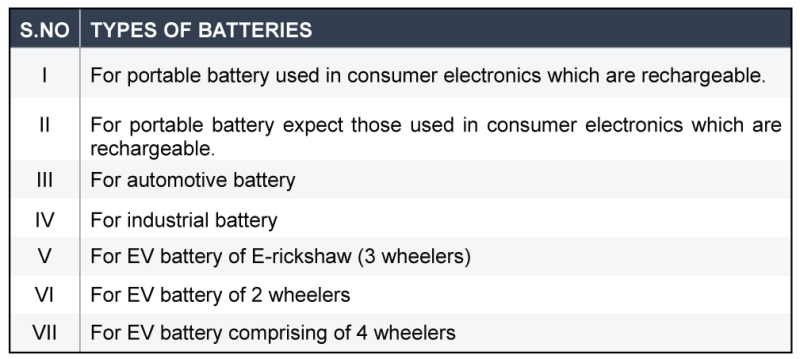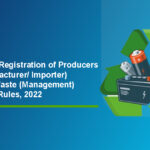EPR and Labelling Requirements for Battery Waste
In this article, we shall describe the concept of ‘Extended Producer Responsibility (EPR)’ and explain the labelling requirements for various types of battery waste under Battery Waste (Management) Rules, 2022.
1. What is EPR (Extended Producer Responsibility)?
EPR (Extended Producer Responsibility) is an environmental policy approach under which ‘Producers/Battery waste Generators’ are responsible for financing the collection, transportation, and disposal of batteries at the end of their useful life. This entails setting up methods for the collection and recycling of used batteries, making sure they are collected separately from other waste products, and attaining predetermined collection and recycling goals.
As per Battery Waste (Management) Rules, 2022 EPR is defined as – “Responsibility of any Producer of Battery for Environmentally sound management of Waste Battery”.
2. Prohibitions on Heavy Metal content in Battery
• Only batteries that contain <= 0.2% (2000ppm) of cadmium (Cd) by weight can be placed in the market.
However, it is not applicable to a portable Battery intended for use in-emergency or alarm systems and medical equipment.
• Batteries that contain <= 0.0005% (5ppm) of mercury (Hg) by weight can be placed only till 2025 in the market.
However, it is not applicable to button zinc silver oxide Battery with a Hg content < 2% and button zinc air Battery with Hg content < 2% by weight.
3. Labelling Requirements
• Producers shall ensure that all battery/ battery packs are marked with labelling requirements as per standards given by BIS (Bureau of Indian Standards).
• No battery or battery packs shall be placed in the market unless it is marked with “crossed out wheeled bin symbol”.
• No battery/ battery packs, containing lead, mercury, or cadmium, shall be placed in the market unless it is marked with respective symbol (Pb/Hg/Cd).
Detailed info of these can be seen in Schedule 1 of Battery Waste (Management) Rules, 2022 on CPCB website – CLICK HERE
4. Type of Batteries Covered Under EPR
• The recycling of Waste Battery means recycling of Battery materials such as lead (Pb), lithium (Li), nickel (Ni), cobalt (Co), plastic, rubber, glass etc.
• The EPR targets shall depend on the types of Battery as mentioned below:

• Examples of ‘rechargeable portable batteries’ used in ‘non-consumer electronic devices:
– Power tools: Such as drills, saws, and sanders.
– Medical devices: Such as blood pressure monitors, and hearing aids etc.
– Solar-powered devices: Such as solar lights and radios
– Marine applications: Such as electric boats, yachts, and submarines.
– Aerospace applications: Such as spacecraft, satellites etc.
– Military applications: Such as night vision devices, and remote sensors etc.
• Examples of ‘rechargeable portable batteries’ used in ‘consumer electronic devices:
– Smartphones, Tablets, Laptop computers, Digital cameras.
– Portable Bluetooth speakers, Wireless headphones.
– Smartwatches and fitness trackers, Portable power banks and chargers.
– Electric toothbrushes, Flashlights, Handheld vacuum cleaners.
– E-readers, Electric shavers, Portable DVD players.
References
*For any queries regarding this article/blog email us at : info@gemrecycling.com

 Previous Post
Previous Post Next Post
Next Post